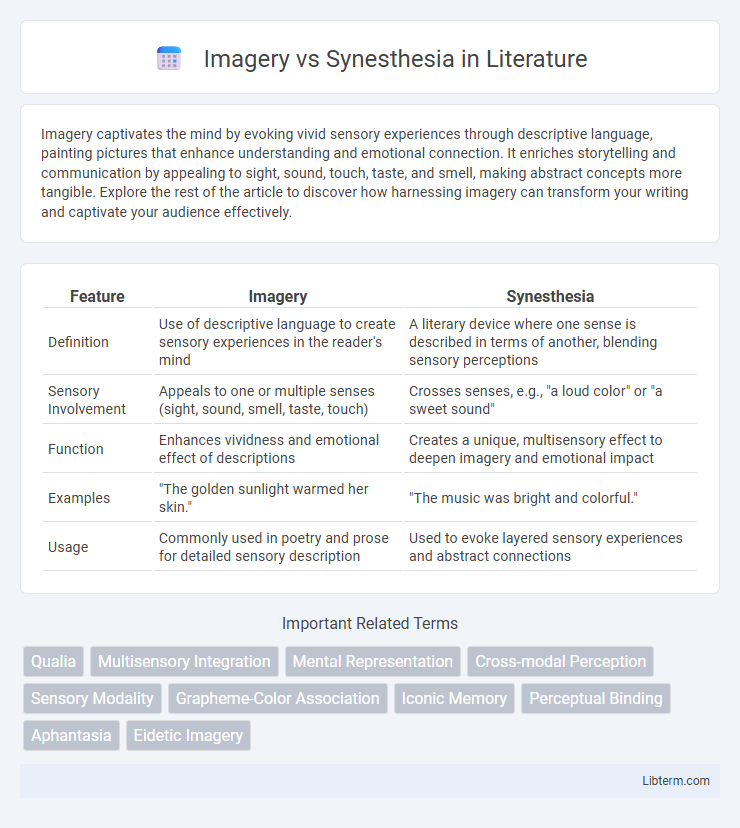Imagery captivates the mind by evoking vivid sensory experiences through descriptive language, painting pictures that enhance understanding and emotional connection. It enriches storytelling and communication by appealing to sight, sound, touch, taste, and smell, making abstract concepts more tangible. Explore the rest of the article to discover how harnessing imagery can transform your writing and captivate your audience effectively.
Table of Comparison
| Feature | Imagery | Synesthesia |
|---|---|---|
| Definition | Use of descriptive language to create sensory experiences in the reader's mind | A literary device where one sense is described in terms of another, blending sensory perceptions |
| Sensory Involvement | Appeals to one or multiple senses (sight, sound, smell, taste, touch) | Crosses senses, e.g., "a loud color" or "a sweet sound" |
| Function | Enhances vividness and emotional effect of descriptions | Creates a unique, multisensory effect to deepen imagery and emotional impact |
| Examples | "The golden sunlight warmed her skin." | "The music was bright and colorful." |
| Usage | Commonly used in poetry and prose for detailed sensory description | Used to evoke layered sensory experiences and abstract connections |
Understanding Imagery: Definition and Types
Imagery refers to the mental representation of sensory experiences, encompassing visual, auditory, tactile, olfactory, and gustatory forms that evoke vivid sensations without external stimuli. Common types include visual imagery, which involves picturing scenes or objects, and kinesthetic imagery, related to physical sensations and movements. Understanding these distinctions helps differentiate typical sensory imagination from synesthesia, where sensory modalities involuntarily intermingle.
What is Synesthesia? An Overview
Synesthesia is a neurological phenomenon where stimulation of one sensory or cognitive pathway leads to involuntary experiences in a second sensory or cognitive pathway, creating blended perceptions such as seeing colors when hearing sounds. Unlike imagery, which is a voluntary and conscious mental visualization or representation of sensory experiences, synesthesia occurs automatically and consistently across individuals. Common forms include grapheme-color synesthesia, where letters or numbers are perceived in specific colors, and sound-to-color synesthesia, highlighting its unique cross-modal sensory integration.
Key Differences Between Imagery and Synesthesia
Imagery involves the mental visualization of sensory experiences, such as picturing a scene or recalling a sound, whereas synesthesia is a neurological condition where stimulation of one sensory pathway involuntarily triggers an automatic, simultaneous experience in another sense, like seeing colors when hearing music. Key differences include the voluntary nature and control over imagery compared to the involuntary, consistent, and automatic cross-sensory perception found in synesthesia. Synesthesia is measurable through tests like the Synesthesia Battery, while imagery varies greatly among individuals and lacks the fixed sensory associations characteristic of synesthetic experiences.
How Imagery Functions in the Human Mind
Imagery functions in the human mind by activating sensory regions to create mental representations of objects, scenes, or experiences without direct external input. This cognitive process enhances memory, learning, and problem-solving by simulating real-world sensations through visual, auditory, or tactile channels. Unlike synesthesia, which involuntarily blends sensory experiences, imagery relies on intentional mental visualization and retrieval from stored knowledge.
The Science Behind Synesthesia
Synesthesia is a neurological condition where stimulation of one sensory pathway leads to involuntary experiences in another, such as seeing colors when hearing music. Brain imaging studies reveal increased cross-activation between sensory regions, particularly between the visual cortex and auditory or somatosensory areas, distinguishing it from voluntary mental imagery. Unlike imagery, which is a conscious and controlled mental process, synesthesia results from atypical neural connectivity and synaptic pruning variations during development.
Real-Life Examples of Imagery
Imagery involves the mental visualization of sensory experiences, such as picturing a vibrant sunset or hearing the distant sound of waves, which helps create vivid and relatable scenes in literature and daily life. Real-life examples include a chef recalling the aroma of freshly baked bread to enhance flavor creativity or a musician imagining the texture of a melody to compose emotionally resonant music. Unlike synesthesia, where senses involuntarily blend (e.g., seeing colors when hearing sounds), imagery relies on deliberate sensory imagination without cross-sensory perception.
Experiencing Synesthesia: Stories and Studies
Experiencing synesthesia involves a unique blending of sensory perceptions where stimuli such as sounds or letters trigger involuntary experiences in another sensory modality, like colors or tastes. Studies reveal that synesthetes often describe vivid, consistent sensory pairings, such as hearing music and seeing specific hues, which differ from ordinary mental imagery that is voluntarily evoked and less automatic. Anecdotal stories emphasize the rich, immersive nature of synesthetic experiences, highlighting their impact on creativity and memory enhancement in individuals with this neurological condition.
The Role of Imagery in Creative Expression
Imagery serves as a fundamental tool in creative expression by enabling artists and writers to evoke vivid sensory experiences through descriptive language and visual representation. Unlike synesthesia, which involuntarily blends sensory perceptions such as associating colors with sounds, imagery is consciously crafted to stimulate the reader's or viewer's imagination and emotional response. Effective use of imagery enhances narrative depth and emotional impact, making abstract ideas tangible and relatable in various art forms.
Synesthesia in Art, Literature, and Music
Synesthesia in art, literature, and music creates a multisensory experience by blending different sensory perceptions, such as seeing colors when hearing sounds or associating tastes with words. Artists like Wassily Kandinsky and composers like Olivier Messiaen used synesthetic concepts to evoke vivid emotional responses by translating sounds into visual forms or colors into musical notes. In literature, writers such as Vladimir Nabokov employed synesthesia to enrich descriptions, deepening readers' engagement by stimulating multiple senses simultaneously.
Comparing the Cognitive Benefits of Imagery and Synesthesia
Imagery enhances cognitive functions by enabling vivid mental visualization that improves memory retention, spatial reasoning, and problem-solving skills. Synesthesia provides a unique multisensory experience that boosts associative memory and creativity by linking sensory modalities, such as seeing colors when hearing sounds. Comparing both, imagery primarily strengthens mental manipulation of sensory information, while synesthesia facilitates cross-modal integration, enriching cognition through enhanced sensory connections.
Imagery Infographic

 libterm.com
libterm.com